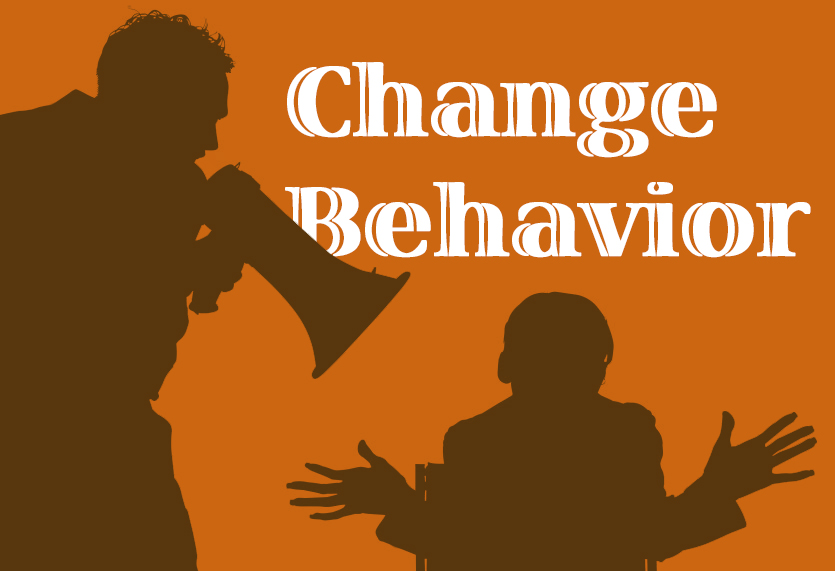 You’re trying to change another‘s behavior primarily because it’s driving you crazy and secondarily it might actually help him or her function better in the world, or at least at work. Our natural inclination is to point out the maladaptation, probably a number of times, potentially nagging or getting angry. Of course all of these attempts are immediate or long-term failures inciting nothing more than frustration and possibly resentment in both parties. What’s an alternative?
You’re trying to change another‘s behavior primarily because it’s driving you crazy and secondarily it might actually help him or her function better in the world, or at least at work. Our natural inclination is to point out the maladaptation, probably a number of times, potentially nagging or getting angry. Of course all of these attempts are immediate or long-term failures inciting nothing more than frustration and possibly resentment in both parties. What’s an alternative?
I came upon an article written in 2006 by Amy Sutherland for the Modern Love section of the New York Times. She speaks of how she was able to encourage positive behavior from her husband around common, but still annoying, actions using animal behavioral science. Basically, she applied the same techniques trainers use to get a dolphin to spin, to get her spouse’s dirty socks off the bedroom floor. It occurred to me the same steps could be applied in the workplace when it comes to the behavior of our direct reports, colleagues, even the boss.
Ms. Sutherland, in her animal behavior research, learned early on that animal trainers are extremely well versed in every aspect of the species they are working with. They understood their likes and dislikes, what was learned versus instinctual, what was viewed as a reward or a punishment; I then thought of my own management style. For some reason, I have always been deeply interested in the “who are they” in my staff. My colleagues would be amazed when I mentioned that the reason something was happening (or not) was because that specific employee had a child with a disability, a parent who was a refugee from Cuba, or had done a tour of duty in a war zone. “How do you know all of this?” I knew their likes (he was a morning person, she a night owl; she would want examples, he evidence) because I observed and asked. I was always curious, sometimes fascinated, in what made them who they are and how they worked best. It made work more interesting and easier.
When I became familiar with and later certified in the Myers Briggs Type Indicator (MBTI), I administered the instrument to those on my staff and my colleagues. It became all the clearer to me how to motivate, reward, and alter behavior. In MBTI speak, you don’t motivate a NT (intuitive thinker) with obvious facts and you surely wouldn’t get very far by telling a “SJ” (sensing judgmental) about the impact a decision would have on the people culture. So I customized my delivery, whether it was in 1×1 supervision, performance evaluations, or casual conversations, to achieve the outcome I wanted — changed or continued behavior. The person felt heard and I got closer to my desired outcome.
I also realized that just as with exotic animals, in order to effectuate change, there must be incremental steps (approximations in behavioral science speak). You ease your way through the course in a measured and scheduled way, so the first goal is for the socks to be off the floor on a Sunday, before ever expecting them off the floor every day of the week.
So often in the workplace, we issue an edict, make a rule, send out the announcement, and expect others will conform. No warm-up or practice, no beta test, no buy-in, only a “just do it.” It doesn’t work with elephants and it rarely works with humans.
Added to the small steps must be specific and immediate rewards. Admit it, we all like recognition and waiting until the end of the project or year probably is not the best timing to maximize results. These rewards need not be elaborate or even public; often, a simple acknowledgement is all anyone wants or needs. I recall with great fondness notes dropped on my desk, a voicemail, or email sent soon after a presentation. These immediate rewards are remembered more often and for longer than something slotted into an annual review months later. It’s in real time and is so much more personal. It makes you want to continue, adjust, and improve. Don’t you agree?
The Times author found kisses worked (though I don’t recommend them in the office).
The next part is hard for me and many of my executive coaching clients. Ignore failures. So the person tries to change and fails, or slips back into a behavior you had hoped would change. Your first inclination is to correct, complain, or at its worst, belittle. (What’s wrong with you?!) Behaviorists would suggest moving on, trying again, pushing the dial rather than rehashing the mistake or omission. The key is not to acknowledge the bad behavior in any way — be emotionless so as not to comment on or reinforce the undesirable. I understand this is not easy but I guarantee it works. My goal as a leader was always to have a short memory for failures and a long memory for successes. Sometimes I was actually able to do it. Many people say you learn from your mistakes. I argue more people learn and hold on to positive outcomes. Practice winning, ignore, or quickly forget less successful outings.
In summary, here are steps to coaching undesirable behavior.
-
Know your subject and tailor the training to their personality, temperament, needs, and desires.
-
Learn what they like and dislike, and use that information in a tactical way.
-
Take incremental steps towards change.
-
Give specific and frequent rewards.
-
Ignore and move past failures; reinforce successes.
Leave a Reply